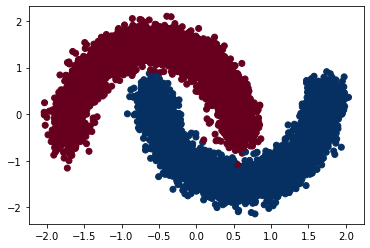Normalizing Flows and RealNVP
Simple implenetation of the RealNVP invertible neural network.
Background
The idea of invertible networks is to learn a reversible mapping from a complicated input (e.g. the two-moons dataset) to a simple latent space (e.g. a standard normal distribution). Once the parameters of the network are learned, we can sample from the latent space and invert the transform to synthesize new examples in the input space.

The high-level picture is that the input is passed through a sequence of layers called coupling layers; and each coupling layer is itself an arbitrarily complicated deep net.
Each coupling layer takes an input x and spits out an output y,
We split the input/outputs each into two parts (e.g. two halves, HalfA and HalfB).
HalfA of the output is exactly HalfA of the input, without changes.
HalfB of the output is HalfB of the input, scaled and translated by arbitrary
functions s and t of HalfA of the input.
s (scaling transform) and t (translating transform) can be complicated
functions, and are usually parameterized as deep nets.
The relationship between x and y in the above eqs is carefully designed to
faciliate simple Jacobian determinant computation.
The tricky part is the input splitting; which half should be HalfA and which should
be HalfB?
What the authors suggest is to stack coupling layers, and alternate the splits such
that HalfA in one layer will be HalfB in the next, and vice versa.
The original RealNVP paper does a good job at explaining the details, so I’m going to show the code below.
The model
The Coupling layers and full RealNVP net are detailed below, with comments. This code is influenced by the Keras implementation.
class Coupling(nn.Module):
"""Two fully-connected deep nets ``s`` and ``t``, each with num_layers layers and
The networks will expand the dimensionality up from 2D to 256D, then ultimately
push it back down to 2D.
"""
def __init__(self, input_dim=2, mid_channels=256, num_layers=5):
super().__init__()
self.input_dim = input_dim
self.mid_channels = mid_channels
self.num_layers = num_layers
# scale and translation transforms
self.s = nn.Sequential(*self._sequential(), nn.Tanh())
self.t = nn.Sequential(*self._sequential())
def _sequential(self):
"""Compose sequential layers for s and t networks"""
input_dim, mid_channels, num_layers = self.input_dim, self.mid_channels, self.num_layers
sequence = [nn.Linear(input_dim, mid_channels), nn.ReLU()] # first layer
for _ in range(num_layers - 2): # intermediate layers
sequence.extend([nn.Linear(mid_channels, mid_channels), nn.ReLU()])
sequence.extend([nn.Linear(mid_channels, input_dim)]) # final layer
return sequence
def forward(self, x):
"""outputs of s and t networks"""
return self.s(x), self.t(x)
class RealNVP(nn.Module):
"""Creates an invertible network with ``num_coupling_layers`` coupling layers
We model the latent space as a N(0,I) Gaussian, and compute the loss of the
network as the negloglik in the latent space, minus the log det of the jacobian.
The network is carefully crafted such that the logdetjac is trivially computed.
"""
def __init__(self, num_coupling_layers):
super().__init__()
self.num_coupling_layers = num_coupling_layers
# model the latent as a
self.distribution = dists.MultivariateNormal(loc=torch.zeros(2),
covariance_matrix=torch.eye(2))
self.masks = torch.tensor(
[[0, 1], [1, 0]] * (num_coupling_layers // 2), dtype=torch.float32
)
# create num_coupling_layers layers in the RealNVP network
self.layers_list = [Coupling() for _ in range(num_coupling_layers)]
def forward(self, x, training=True):
"""Compute the forward or inverse transform
The direction in which we go (input -> latent vs latent -> input) depends on
the ``training`` param.
"""
log_det_inv = 0.
direction = 1
if training:
direction = -1
# pass through each coupling layer (optionally in reverse)
for i in range(self.num_coupling_layers)[::direction]:
mask = self.masks[i]
x_masked = x * mask
reversed_mask = 1. - mask
s, t = self.layers_list[i](x_masked)
s = s * reversed_mask
t = t * reversed_mask
gate = (direction - 1) / 2
x = (
reversed_mask
* (x * torch.exp(direction * s) + direction * t * torch.exp(gate * s))
+ x_masked
)
# log det (and its inverse) are easily computed
log_det_inv = log_det_inv + gate * s.sum(1)
return x, log_det_inv
def log_loss(self, x):
"""log loss is the neg loglik minus the logdet"""
y, logdet = self(x)
log_likelihood = self.distribution.log_prob(y) + logdet
return -torch.mean(log_likelihood)
mdl = RealNVP(num_coupling_layers=6)
Learning an invertible transform
With the model set up, we can now run it and try to whiten the two-moons data seen above, then try to invert it back to the input space.
params = []
for l in mdl.layers_list:
params.extend([p for p in l.parameters()])
optim = torch.optim.Adam(params, lr=.001)
losses = []
num_epochs = 3000
pbar = tqdm(range(num_epochs))
n_pts = 512
for epoch in pbar:
x0, y0 = get_moons(n_pts=n_pts) # get new synthetic data
loss = mdl.log_loss(x0)
optim.zero_grad()
loss.backward()
optim.step()
pbar.set_postfix({ "loss": f"{loss:.3f}"})
losses.append(loss.detach())
Plotting the learned transformation
I’m showing the loss below, where we can see that the network is clearly learning.

Finally, we can plot what our RealNVP network has learned. On the left we have our input data, in the middle we can see the latent space, and on the right we have the latent space data transformed back (i.e. inverted) to the input space. Plotting code is in the repo linked at the top.
# map from input to latent space
x0, y0 = get_moons(n_pts=10000)
z, log_like = mdl(x0)
z = z.detach()
# map from latent back to input space
x1, _ = mdl(z, training=False)
x1 = x1.detach()






